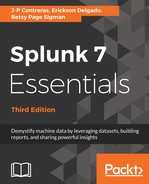Book Description
Transform machine data into powerful analytical intelligence using Splunk
About This Book
- Analyze and visualize machine data to step into the world of Splunk!
- Leverage the exceptional analysis and visualization capabilities to make informed decisions for your business
- This easy-to-follow, practical book can be used by anyone - even if you have never managed data before
Who This Book Is For
This book is for the beginners who want to get well versed in the services offered by Splunk 7. If you want to be a data/business analyst or want to be a system administrator, this book is what you want. No prior knowledge of Splunk is required.
What You Will Learn
- Install and configure Splunk for personal use
- Store event data in Splunk indexes, classify events into sources, and add data fields
- Learn essential Splunk Search Processing Language commands and best practices
- Create powerful real-time or user-input dashboards
- Be proactive by implementing alerts and scheduled reports
- Tips from the Fez: best practices using Splunk features and add-ons
- Understand security and deployment considerations for taking Splunk to an organizational level
In Detail
Splunk is a search, reporting, and analytics software platform for machine data, which has an ever-growing market adoption rate. More organizations than ever are adopting Splunk to make informed decisions in areas such as IT operations, information security, and the Internet of Things.
The first two chapters of the book will get you started with a simple Splunk installation and set up of a sample machine data generator, called Eventgen.
After this, you will learn to create various reports, dashboards, and alerts. You will also explore Splunk's Pivot functionality to model data for business users. You will then have the opportunity to test-drive Splunk's powerful HTTP Event Collector. After covering the core Splunk functionality, you'll be provided with some real-world best practices for using Splunk, and information on how to build upon what you've learned in this book.
Throughout the book, there will be additional comments and best practice recommendations from a member of the SplunkTrust Community, called "Tips from the Fez".
Style and approach
This fast-paced, example-rich guide will help you analyze and visualize machine data with Splunk through simple, practical instructions and recommendations.
Downloading the example code for this book You can download the example code files for all Packt books you have purchased from your account at http://www.PacktPub.com. If you purchased this book elsewhere, you can visit http://www.PacktPub.com/support and register to have the files e-mailed directly to you.
